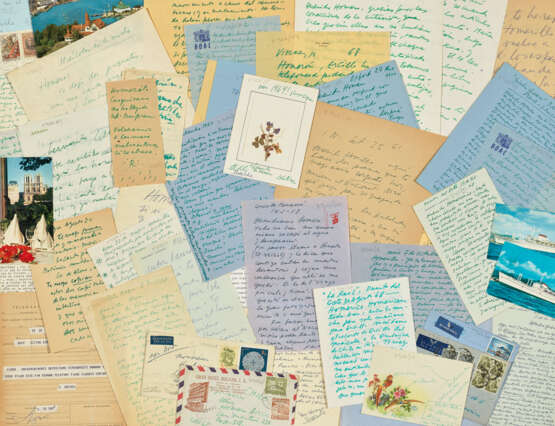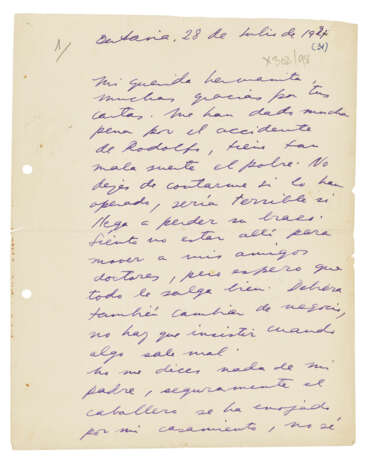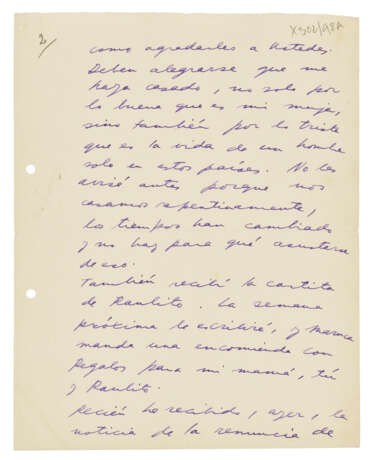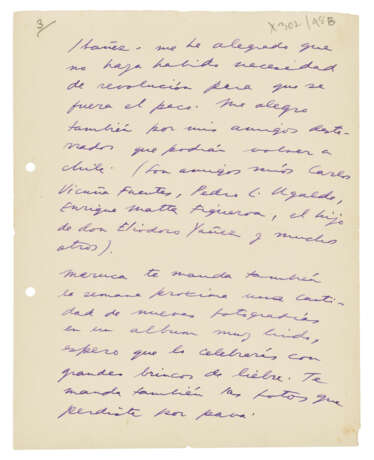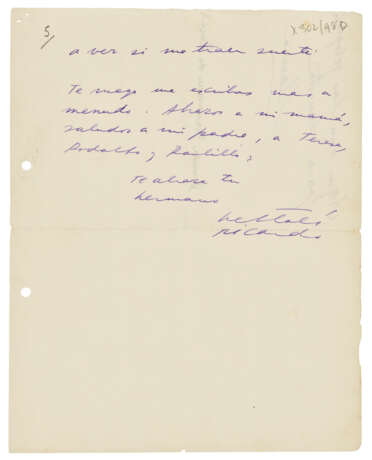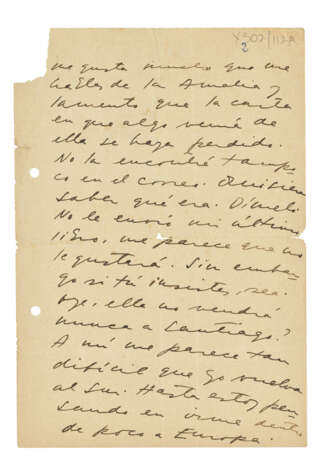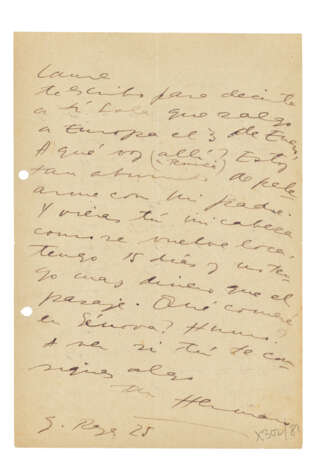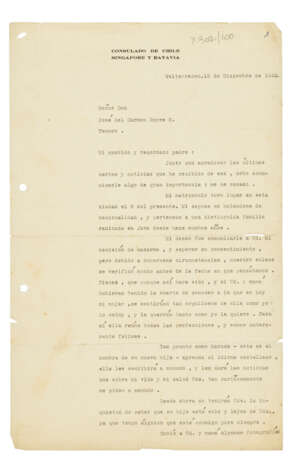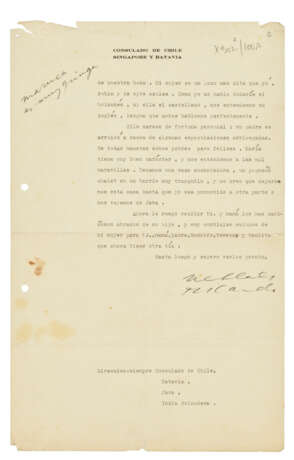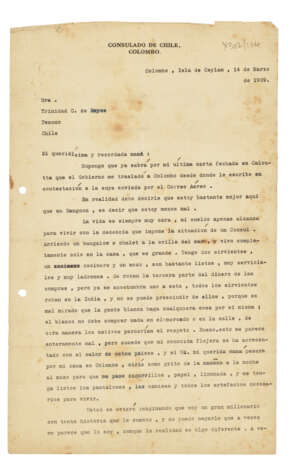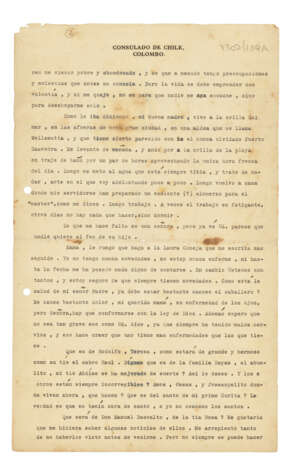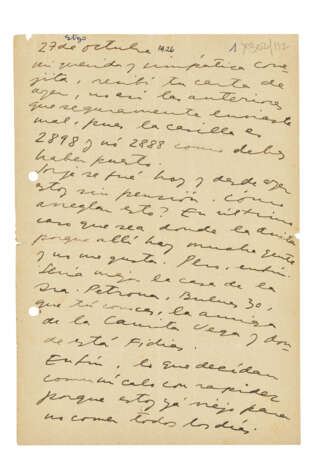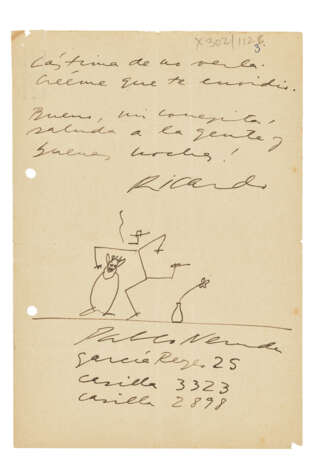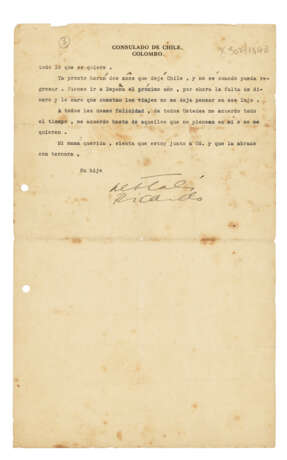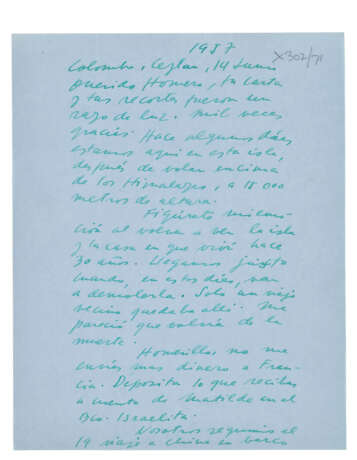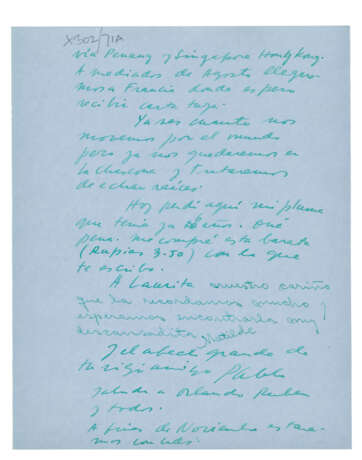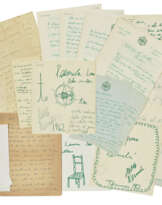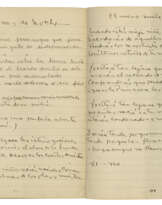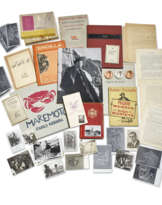ID 1349693
Lot 99 | Pablo Neruda (1904-1973)
Valeur estimée
£ 20 000 – 25 000
More than 100 autograph and typed letters signed ('Ricardo', 'Pablo', 'tu hermano'), postcards, telegrams, memoranda and further ephemera addressed to his sister, his father, his stepmother and his secretary Homero Arce, Santiago, Rangoon, Colombo (Sri Lanka), Batavia and Weltevreden (Java), Buenos Aires, Rio de Janeiro, Paris, Budapest, Montevideo, Isla Negra, Helsinki, Tokyo, Rome, London, Jamaica, Punta del Este, Oxford, Cuba, Moscow and other locations, c.1925-15 August 1972
In Spanish. The recipients are: his half-sister, Laura Reyes (‘querida coneka’, ‘conejita’, ‘hermanita’; c.43 items, including one letter in the hand of his first wife, ‘Maruca’); his father, José del Carmen Reyes Morales (5 items); his stepmother, Trinidad Marverde (2 items); and his secretary, Homero Arce (45 items; along with a number of envelopes, 5 autograph notes or memoranda, and other ephemera including a telegram to Neruda from García Marquez, 27 June 1968). Provenance: Sotheby’s, 29 April 1980, lot 529 and 11 November 1982, lots 165-166 (part lots).
An important correspondence spanning much of Neruda's adult life, from youthful impecuniousness as a junior diplomat to his elevation as Chile’s national poet, with the final letter to his sister written a year before his death. The earliest and perhaps most revealing letters of the collection are addressed to Laura; these give way primarily to postcards, and Neruda’s correspondence with his secretary and friend Homero Arce begins in 1955, with the letters from the final two decades of his life dealing mainly with literary and financial practicalities. The correspondence opens with a letter to Laura dated c.1925: Neruda is living in Santiago and working on Residencia en la tierra but writes only to his younger sister of a cat he has adopted. The following year, however, in October 1926, Neruda begs for her opinion of his book (‘Have you read it? Tell me…’), as well as lamenting his straitened circumstances, a recurring theme. On 31 May 1927, he informs Laura of his appointment as consul in Rangoon; from this point onwards, letters arrive from various postings in south Asia, illustrated with accounts of local life and his work often coloured by frustration, boredom and a longing to be elsewhere. Writing from Rangoon on 31 March 1928, he finds himself more accustomed to the climate and has purchased a Kodak camera, but ‘my main interest is in Europe: I only want to live there’ or, perhaps, Japan. The correspondence from the diplomatic days contains frequent complaints about the cost and conditions of living, alongside a dose of self-pity for what he describes as his lonely existence, all his friends either removed to Europe or failing to write to him from Chile. Governmental politicking often results in uncertainty around postings and Neruda feels keenly the precarity of his existence: in a letter to his father sent from Santiago in 1933, he regrets that his ‘vagabond life’ will see him posted to Buenos Aires without a chance to say goodbye. An apparently carefree and ebullient letter to his father from Java on 15 December 1930 to announce his marriage to Marijke Antonieta Hagenaar – ‘to me she is perfect and we are entirely happy’ – only briefly acknowledges that he might have sought his father’s blessing, while a letter to Laura the following year asks if news of his marriage has upset his father, who should only be happy that he has wed, ‘not only for how good my wife is, but for how sad life is for a single man in these countries’. Elsewhere, he writes to Laura of leaving Temuco for Europe as he is ‘bored of fighting with my father’; in a letter to Trinidad Marverde sent from Sri Lanka on 14 March 1929, Neruda again complains about his salary – ‘barely enough to live as befits the post of Consul […] You will have imagined that I am a multimillionaire […] and I cannot deny that at times it has seemed to me that I am, but the reality is somewhat different. At times I feel poor and abandoned, and I often experience worries and annoyances that I did not know before’. He writes to Laura in March 1934 with happy news, telling her that she will be an aunt in August, but in 1937 informs her that his wife has taken their little girl to live with her family in Holland; for every burst of cheerfulness in the letters from this period – such as the gleeful report that good living has seen him swell to 80 kilograms – there are far more dolorous accounts of ill-health, salary woes and, on one occasion, the problems of publishing a book in Spain.
It is a different Neruda who writes to Homero Arce – and sends postcards to Laura – from 1955 onwards: now the famous writer travelling the world in style, with Matilde Urrutia at his side. The invariably ‘urgent’ missives sent from across the globe contain updates on and corrections to his work and discussion of the work of others, mention arrangements with the periodicals for whom he wrote, ask his secretary to forward letters according to Neruda’s frequently-changing location, and often include requests to deal with financial matters. Although complaints of ill-health and overwork do continue, they are counterbalanced by moments of appreciation: in 1957, his excitement at returning to the house in Sri Lanka in which he lived 30 years ago; in 1965, describing with approval the British Museum and his degree ceremony at Oxford and, on a cruise near the Canaries, remarking that he has seen no such beauty in 40 years of travel. The final letter, of 15 August 1972, is written to Laura from France, before ill-health necessitated his return from his final diplomatic posting. In a light-hearted letter Neruda describes life at his country retreat ‘La Manquel’, where work with Homero ‘follows the same routine every day: 20 minutes of work and eight hours of relaxing’.
Pablo Neruda grew up in Temuco with his father, stepmother Trinidad Candia Malverde, and half-sister Laura Herminia. In 1930, Neruda married his first wife, Marijke Antonieta Hagenaar Vogelzang; his third wife, whom he wed in 1966, was the Chilean singer Matilde Urrutia. Homero Arce was a close friend and secretary to Pablo Neruda for over fifty years.
| Artiste: | Pablo Neruda (1904 - 1973) |
|---|---|
| Lieu d'origine: | Amérique du Sud |
| Catégorie maison de vente aux enchères: | Lettres, documents et manuscrits, Livres et manuscrits |
| Artiste: | Pablo Neruda (1904 - 1973) |
|---|---|
| Lieu d'origine: | Amérique du Sud |
| Catégorie maison de vente aux enchères: | Lettres, documents et manuscrits, Livres et manuscrits |
| Adresse de l'enchère |
CHRISTIE'S 8 King Street, St. James's SW1Y 6QT London Royaume-Uni | |
|---|---|---|
| Aperçu |
| |
| Téléphone | +44 (0)20 7839 9060 | |
| Commission | see on Website | |
| Conditions d'utilisation | Conditions d'utilisation |
